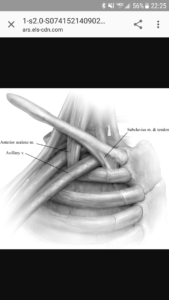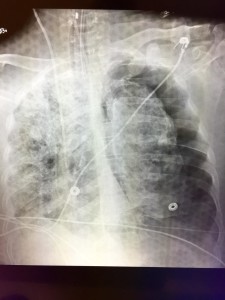Another weird one for you all. 42yo wm presents with 2 weeks of intermittent right arm swelling and pain. Worse with exertion. Some numbness of the fingertips. Seen 1 week prior. No labs done. US negative. So I walk into the room and stop in my tracks. Dude looks like he should be jumping off a turnbuckle in a pro wrestling match. Absolutely huge. Second thing I notice is despite being ripped bilaterally, I can see from 20 feet away, his right arm is almost twice the size of his left. Third, I immediately decide this cat gets whatever he wants for pain because there are peanuts in his stool bigger than me.
Start my exam. Guy states he works out 5-6 hours a day. Swelling went down with rest and immobilization/elevation . Started training for a bodybuilding show 3 days ago and it came back with avengence. Swelling is diffuse and symmetric, extends all the way to the distal pectoral muscle on the lateral chest wall. Subjective numbness to the digits, non focal. Cap refill < 2 seconds. 5/5 strength (more like 9/5) full range of motion. Lung exam normal. No neck or supraclavicular masses. Prominent superficial veins of neck and pectoral area. Bilaterally but right noticeably greater than left. Only other important note, does add he had a history of Non-Hodgkins lymphoma when he was a teenager.
So…….what now? I decide I am worried about venous outflow or lymphatic obstruction from a mass amongst other things. Talk to our radiologist about best imaging. He recommends CTA of chest and ‘I’ll tell them to get the neck too’ . Lab him up- cbc, bmp, ck. All normal. Radiologist calls me with this report ‘i see some schmutz in the axillary region, consistent with superficial thrombophlebitis’.
Go back and check on him. Looks miserable, states arm feels even tighter. I decide this seems extreme for superficial thrombophlebitis. Order a repeat US. Field the inevitable ‘he just had one a week ago ‘ call. Lo and behold, axillary DVT that extends through all the distal venous circulation.
This is called Paget-Schroetter syndrome. Effort induced thrombosis of the upper extremity. The axillary vein sits right in between the clavicle and first rib. Can get a ‘nutcracker’ compression of it.

Then repeated shear force causes fixed intrinsic damage and extrinsic scar tissue formation. Making the vessel extremely prone to clot formation . So patients with a tight squeeze on the axillary vein at baseline who are active in exercises that increase shear are prone. Classic examples are bodybuilders like this guy and baseball pitchers . For you gunners (nerds) the distention of the chest wall superficial veins association with this condition is called Urschel’s sign. Treatment consist of anticoagulation and consideration of thrombolysis as most of these patients are young, healthy, and active . Surgical first rib resection is an option for refractory cases.
I started him on heparin in case vascular or IR was interested in lysing him. They weren’t, and he was discharged home on xarelto in good condition after an obs admission for n/v checks. Thought about following up by looking him up on Facebook, but that would entail entirely too many pics of him flexing with a spray tan and a Speedo.
Couple of learning points I think .
#1 if you have an index of suspicion for a dvt or a positive d dimer, repeat ultrasound at 1 week. Hold your ground if you get pushback. The data is behind you and I catch one about 2 times a year. Initial US too early at times and it propagates later.
#2 if you have a weird case, talk to your radiologist early. Give them background and get them invested in the test. You will get a 1000x better read and likely way more timely of a read. Good rule of thumb in general- better reason for the test, better read. I see this all the time, we piss and moan about radiology hedging, then we look back at the indication given and it’s something generic like ‘abdominal pain’
![Room9er ["Room Niner"]:](https://room9er.com/wp-content/uploads/2020/03/cropped-Screen-Shot-2020-03-08-at-3.16.16-PM.png)


